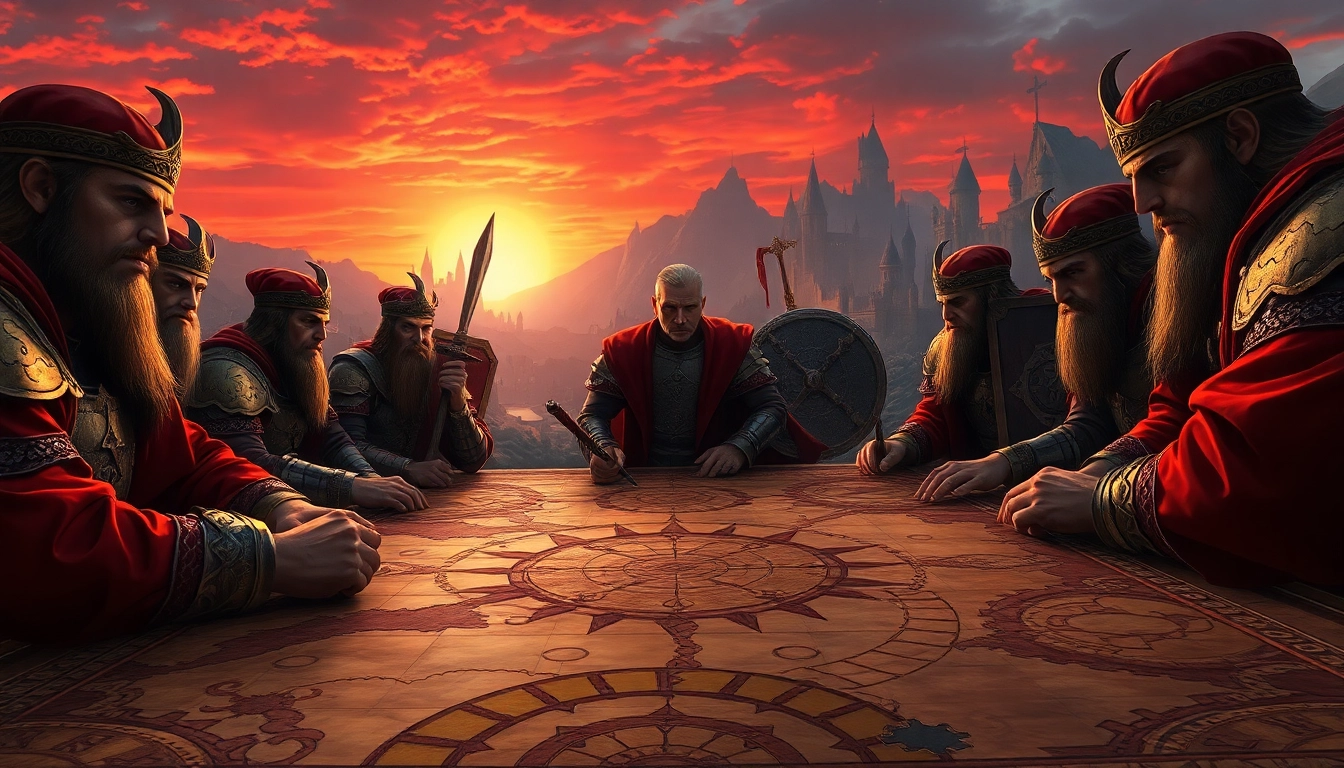The Legacy of Warlords: A Historical Overview
The term warlords evokes powerful imagery and narratives rooted in both historical and mythical contexts. The concept of a warlord stretches back to ancient times, characterized by its intersection with culture, power, and conflict. Through this exploration, we seek to understand the origins, diverse cultural representations, and the evolution of warlords in gaming—an area that significantly influences the contemporary landscape of video game narratives.
1. Origins of the Warlord Concept
The origins of the warlord concept can be traced to various civilizations, often arising in contexts where centralized authority was weak or absent. In early societies, leaders emerged not only as military commanders but also as figures of authority, consolidating power through warfare, territory expansion, and alliances.
Historically, the term ‘warlord’ gained prominence in the late 19th and early 20th centuries, primarily in reference to political and military leaders in China during the warlord era (1916-1928). These leaders operated regional armies and governed territories, often acting independently of the central government. Their legacy is a reflection of how power dynamics shape sociopolitical landscapes.
2. Warlords in Different Cultures
Across cultures, the archetype of the warlord manifests in varied forms. In medieval Europe, for instance, feudal lords wielded military power over their domains, asserting control through vassalage and warfare. In the Japan of the samurai era, figures like Oda Nobunaga and Toyotomi Hideyoshi exemplified the warlord model, utilizing both cunning and brute force to unify Japan.
In contrast, African cultures saw the rise of leaders such as Shaka Zulu, who transformed the Zulu kingdom into a formidable military force using innovative tactics and extensive organization. Here, the warlord is intricately woven into the cultural identity, shaping narratives of heroism and valor.
The Global context demonstrates that while the attributes of warlords may differ, their impact on society and culture remains a constant thread, illustrating the complexity of governance and authority in human history.
3. Evolution of Warlords in Gaming
In the realm of gaming, the evolution of the warlord archetype mirrors historical changes and cultural influences. Early strategy games showcased warlords primarily as commanders on battlefields, focusing heavily on military strategy and territory expansion. As gaming technology advanced, so too did the narrative depth of warlords, evolving from mere figures of authority to complex characters with rich backstories.
Franchises like “Warcraft” and “Total War” illustrate this shift; they feature warlords who navigate political intrigue, alliances, and the fallout of warfare. More recent games invite players to personalize their warlord experience, exploring their motivations and the personal costs of power. This evolution has enabled games to delve into themes of morality, sacrifice, and the burdens of leadership, offering players a more immersive and reflective experience.
Game Mechanics: Understanding Warlord Dynamics
The dynamics of warlords in gaming hinge on a combination of character attributes, skills, and strategic positioning within the gameplay mechanics. Understanding these elements is crucial for players aiming to master their warlord characters.
1. Key Features of Warlord Characters
Warlords in gaming typically possess key features that define their roles and capabilities. These may include:
- Leadership Abilities: The ability to inspire troops and boost their performance on the battlefield.
- Combat Skills: Proficiencies in various weapons and fighting styles that enhance effectiveness in battles.
- Tactical Acumen: Skills that enable players to devise complex strategies, manipulating terrain and unit positioning for optimal results.
- Resource Management: An essential feature that includes the ability to gather resources, maintain supply lines, and manage settlements or armies efficiently.
2. Comparing Warlords Across Games
Comparing warlords across various gaming titles reveals distinct flavors of leadership and combat. For instance, in “Warlords II Deluxe,” players assume the role of a warlord amidst a fantasy setting rich in magic and mythical beings. The unique attributes and abilities attributed to each warlord impact gameplay, influencing everything from combat style to diplomatic relations.
In contrast, games like “Total War: Warhammer” expand this concept by introducing a wider array of races, each possessing unique warlord characteristics. Such comparisons offer insights into how different games interpret the warlord archetype, providing players diverse experiences grounded in the underlying mechanics and narrative design.
3. Strategies to Enhance Your Warlord’s Skill Set
To maximize the potential of a warlord character, players can adopt several strategies aimed at enhancing their skill sets:
- Balance Attributes: Rather than specializing in one area, strive for a balanced set of attributes that enables versatility on the battlefield.
- Leverage Environment: Understand the terrain—using it to gain tactical advantages can shift the tide of battle.
- Invest in Relations: Building alliances can provide critical support and resources, transforming a warlord’s capabilities.
- Adapt Through Experience: Engage in multiple scenarios to refine and adapt strategies. Learning from losses can be as valuable as victories.
Building Your Warlord: Attributes and Skills
The process of building a warlord character involves understanding the essential attributes and skills that define success in both gameplay and storytelling contexts.
1. Essential Attributes for Success
When constructing a warlord character, several attributes are pivotal:
- Strength: Often a measure of combat ability, enabling the warlord to wield greater power in battles.
- Intelligence: Crucial for employing strategic insights, foresight in planning, and crafting effective tactics.
- Charisma: Vital for influencing allies and negotiating peace or war with various factions.
- Wisdom: Represents the experience and insight needed for making critical decisions under pressure.
2. Skills That Define a Dominant Warlord
The skills that nurture a warlord’s prowess can be categorized into various levels, ranging from basic to advanced skills. Players might focus on:
- Combat Skills: Mastery over different weapon types, including melee and ranged combat.
- Negotiation Skills: Engaging in diplomacy to bolster alliances or manipulate enemy factions.
- Tactical Planning: The capacity to formulate strategies that consider both immediate and long-term objectives.
3. Crafting a Unique Warlord Persona
To truly engage with the character, players can craft unique narratives around their warlord personas. This involves:
- Backstory Creation: A compelling backstory fuels player engagement and investment in the character’s journey.
- Dynamic Decision-Making: Allowing in-game choices to reflect the character’s personality traits, altering how the story unfolds.
- Character Development: Implementing progressive character arcs that evolve reflecting triumphs and challenges.
Competitive Strategies: Outmaneuvering Opponents
Mastering warlord gameplay requires an understanding of competitive strategies that can outsmart opponents. This section outlines vital aspects including combat styles, team strategies, and tactical maneuvers.
1. Analyzing Warlord Combat Styles
Warlord combat styles vary widely, each requiring different approaches in battle:
- Heavy Assault: A style that relies on overwhelming power and direct engagement, often sacrificing speed for brute force.
- Stealth Tactics: Using agility and cleverness, players can ambush opponents and outmaneuver them in battles.
- Defensive Strategies: Emphasizing fortification and counter-attack strategies to wear down enemies over time.
2. Team Strategies for Warlord Leaders
In many games, warlords do not operate in isolation but lead teams. Successful strategies may include:
- Diversified Roles: Assembling a team with varied skills ensures coverage across all operational needs.
- Centralized Command: Ensure clear communication and strategies flow from the warlord to all team members.
- Adaptive Planning: Be prepared to modify tactics based on opponents’ weaknesses and battlefield conditions.
3. Defensive and Offensive Warlord Tactics
Tactics are essential in defining how a warlord engages in battle, covering both offensive and defensive plays:
- Offensive Tactics: Involve direct engagement with the enemy, using overwhelming force to secure swift victory.
- Defensive Tactics: Focus on protecting territory while waiting for opportunities to exploit the enemy’s mistakes.
- Counteroffensives: Involves luring enemies into traps or overextending themselves, allowing for strategic reclaiming of lost ground.
Community and Culture: The Rise of Warlord Fandom
The phenomenon of warlords in gaming extends beyond mere gameplay; it has engendered a community and culture surrounding them, comprising a fanbase that engages through various mediums.
1. Engaging with Warlords in Online Forums
Online platforms foster communities where fans discuss strategies, share achievements, and create fan art centering on their favorite warlords. Forums have emerged as a rich repository of knowledge, where experienced players impart insights, while newcomers exchange tips and build camaraderie.
2. Fan Art and Media Celebrating Warlords
Fan art channels creativity, allowing enthusiasts to express their interpretations of warlords through various artistic forms. This extends to cosplay, videos, and streams, celebrating the narratives and strategies associated with the characters. Such media not only reflects the characters but also fosters a deeper connection to the gaming experience.
3. The Future of Warlords in Gaming
As gaming technology evolves and storytelling mechanisms advance, the portrayal of warlords is poised to become more nuanced. Bringing in elements of psychological depth and ethical dilemmas allows for richer player experiences. Gaming developers are likely to explore these complexities, emphasizing themes of power, morality, and leadership through the lens of the warlord archetype, while expanding their roles within the narrative.




